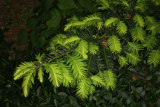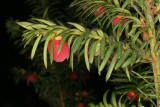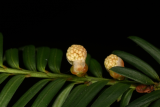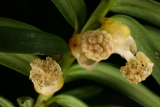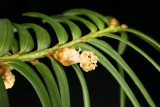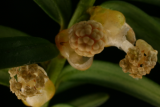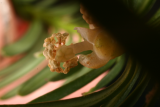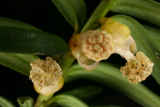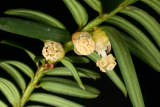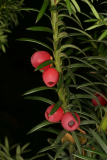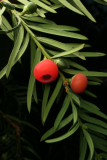Additional notes (click to expand)
Horticulture
This cultivar is is columnar and female, with radially set leaves up to 10m (30ft) high and 6m (20ft) wide.
Grow in any well-drained, fertile soil, including chalky or acid soils, in sun or deep shade. Trim hedging in summer and early autumn. Can withstand renovation pruning.
Insert semi-ripe cuttings in later summer or early autumn; take cuttings from strongly upright shoots (except for prostrate cultivars) otherwise they make not from a strong leading shoot. Graft cultivars in early autumn.
Resistant to most diseases, except Phytophora root rot. May be damaged by tortrix moth caterpillars, vine weevil, and yew scale.
Brickell, C. (2003). A-Z Encyclopedia of Garden Plants. Dorling Kindersley. p.1026
Medicinal
In 1960 a survey of plants for anticancer activity by the National Cancer Institute in the USA found a concentration of 0.0004% a chemical, Taxol, a taxane diterpene with cytotoxic activity, in the bark of the Pacific Yew, Taxus brevifolia. Its structure was finally determined in 1995. It is very difficult to synthesize and this was accomplished in 1994 by a 26 step process. Interest in it was increased when it was realised that it had a unique mode of action as a 'spindle poison' by stabilizing microtubules and inhibiting depolymerisation back to tubulin during cell division (mitosis). 380,000 mature Pacific yew trees would have been needed annually to supply enough Taxol for the North American market alone, and with the difficulties in synthesis this was unsustainable. However precursors, such as 10-deacetylbaccatin, were discovered in larger amounts in the needles of the European yew, Taxus baccata, which could be easily converted to Taxol. Hedge cuttings are a renewable resource and for years these were used for Taxol production, but now yew tree cell lines are cultured (and the precursors sourced) in large scale fermentation tanks.
Also marketed as Paclitaxel for ovarian cancer and secondary treatment for breast and non-small-cell lung cancers. Doxetaxel is used for breast and ovarian cancers and was approved for use in the USA in 1995..
Heinrich, Michael, Barnes, Joanne, Gibbons, Simon, Williamson, Elizabeth M. (2013). Fundamentals of Pharmacognosy and Phytotherapy. Churchill Livingstone Esevier. page 135, 136
Although regarded as poisonous since Theophrastus, Gerard and his school friends used to eat the red berries (they are technically called 'arils') without harm. Johnson clearly ate the fleshy arils and spat out the seed, which is as poisonous as the leaves. It is a source of paclitaxel (Taxol), an important chemotherapeutic agent for breast and other cancers. It was first extracted from the bark of T. brevifolia, the Pacific yew tree, in 1966. About 1,100 kg of bark produces 10 g of Taxol, and 360,000 trees a year would have been required for the needs of the USA – an unsustainable amount. In 1990 a precursor of Taxol was extracted from the needles of the European yew so saving the Pacific trees. It is now produced in fermentation tanks from cell cultures of Taxus. Curiously, there is a fungus, Nodulisporium sylviforme, which lives on the yew tree, that also produces taxol. Because Taxol stops cell division, it is also used in the stents that are inserted to keep coronary arteries open. Here it inhibits – in a different way, but like anti-fouling paint on the bottom of ships – the overgrowth of endothelial cells that would otherwise eventually block the tube. The economic costs of anticancer drugs are significant. Paclitaxel ‘Taxol’ for breast cancer costs (2012) £246 every 3 weeks; DoCetaxel (synthesised from paclitaxel) for breast, ovarian and other cancers costs up to £900 every three weeks; Cabazitaxel (a further synthetic) for prostate cancers costs £3,698 every 3 weeks and because of the cost is only licensed to be used in the UK after other treatments fail. Doxyrubicin (cost £915) from a bacteria, Streptomyces peucitius, is the main breast cancer drug now (2013).
Oakeley, Dr. Henry F. (2013). Wellcome Library notes.
link
Nomenclature
'Fastigiata'- Having branches closely together and erect, often forming a column; fastigiate.
Stearn, W.T. (1996). Dictionary of Plant Names for Gardeners. Cassell. p.139
Trees are feminine in Latin, so while Taxus has a masculine ending (-us), its specific name, baccata, agrees with it in gender by having a female ending (-a). In Latin, baccata means 'having fruits with a pulpy texture.'
Stearn, W.T. (1996). Dictionary of Plant Names for Gardeners. Cassell. p.58
Other use
Ancient Celts poisoned arrows tips and spears with Taxus extracts.
Wink, Michael & Ben-Erik van Wyk (2008). Mind-Altering and Poisonous Plants of the World. Timber Press
Yew wood possesses high elasticity and toughness. It made Anglo-Saxon longbows, the most dreaded long-range weapon of the Middle-Ages that had unparalleled penetrating power. Archers had to develop a tractive force of 85kg when drawing their bows. During the battle of Agincourt in 1415, a large portion of the French aristocracy perished in the rain of arrows unleashed from the English longbows, despite the armour the French wore when they charged.
Petersen, F. (2012). Physic Garden Medicinal Plant Guide. Novartis Pharma AG. p.133
Phytochemistry
Taxol is a taxane diterpene, 'a highly functional molecule possessing esters, epoxides, hydroxyls. amide, ketone groups and unsaturation. It has large numbers of chiral centres...'
Heinrich, Michael, Barnes, Joanne, Gibbons, Simon, Williamson, Elizabeth M. (2013). Fundamentals of Pharmacognosy and Phytotherapy. Churchill Livingstone Esevier.
The bark, needles and fruit (seed) of all species of yew contain a family of related alkaloids collectively called Taxines of which the most important are Taxine A and Taxine B, and Paclitaxel, the important anticancer drug popularly called Taxol and available as an anticancer drug under the trade name TAXOL®. Taxine B is responsible for most of the toxicity of yew as it is a potent and relatively cardio-selective calcium channel blocker.
Christina R. Wilson, John-Michael Sauer 1, Stephen B. Hooser. Toxicon 39 (2001),Taxines: a review of the mechanism and toxicity of yew (Taxus spp. ) alkaloids 175±185
Toxicity
"The Yew Tree, as Galen reporteth, is of a venemous qualities, and against man's nature. Dioscorides writeth ...that the yew is very venemous to be taken inwardly, and that if any doe sleepe under the shadow thereof it causeth sickness and oftentimes death, Morevoer, they say that the fruit thereof being eaten is not only dangerous and deadly unto man [but also birds].... Theophrastus saith that ... labouring beasts do die if they do eat of the leaves, but such cattle as chew their cud receive no hurt at all thereby'. Gerard notes that he and his school friend ate the berries and slept under yew trees without being poisoned, but the fleshy aril round the seeds is said to be harmless, and only the seed is poisonous, so presumably he spat the seed out. Theophrastus's observations re cattle (circa 340BCE) are repeated in more modern texts.
Gerard, J. (1975). The Herbal or General History of Plants. New York: Fascimile Dover Publications Inc . p.1371
Eating the needles or fruit (seeds) causes primarily slowing and weakening of the heart and inhibition of intestinal movements. The result is weakness, vomiting and diarrhoea, broadening of the ECG, disorders of intracardiac conduction and finally death mainly due to hypotension, seizures and ventricular dysrhythmias. The LD50 (fatal dose) of needles is about 0.7-2g/kg in most mammals depending on age and weight. It is some 8-times less toxic in the chicken.
Ondřej Piskač A, Jan Stříbrný, Hana Rakovcová, Martin Malý “Cardiotoxicity of yew“ c o r e t v a s a. 5 7 ( 2 0 1 5 ) ,e 2 3 4 – e 2 3 8
Geographical distribution
- Africa, Northern Africa, Algeria
- Africa, Northern Africa, Morocco
- Asia-Temperate, Caucasus
- Asia-Temperate, Western Asia, Iran
- Asia-Temperate, Western Asia, Turkey
- Europe, Eastern Europe, Central European Russia
- Europe, Eastern Europe, North European Russia
- Europe, Eastern Europe, South European Russia
- Europe, Eastern Europe, Ukraine
- Europe, Middle Europe, Austria
- Europe, Middle Europe, Germany
- Europe, Southeastern Europe, Italy
- Europe, Southeastern Europe, Yugoslavia
- Europe, Southwestern Europe, France
- Europe, Southwestern Europe, Portugal
- Europe, Southwestern Europe, Spain
Podcast
Taxus baccata L. 'Fastigiata'
Family: TAXACEAEGenus: Taxus
Species: baccata L.
Cultivar: 'Fastigiata'
Common names: Irish Yew
Distribution summary: Eurasia
Habit: Tree
Hardiness: H5 - Hardy; cold winter
Garden status: Currently grown
Garden location: Plants of the World (B), Plants of the World (C)
Flowering months: March, April
Reason for growing: Medicinal, other use, toxic, prescription only medicine
